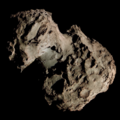 Comet 125P/Spacewatch photographed from the Zwicky Transient Facility on 3 June 2024 | |
| Discovery [1] | |
|---|---|
| Discovered by | Spacewatch Tom Gehrels |
| Discovery site | Kitt Peak Observatory |
| Discovery date | 8 September 1991 |
| Designations | |
| P/1991 R2, P/1996 F1 | |
| 1990 XXIX, 1991x | |
| Orbital characteristics [2] [3] | |
| Epoch | 11 August 2015 (JD 2457245.5) |
| Observation arc | 33.12 years |
| Number of observations | 1,297 |
| Aphelion | 4.728 AU |
| Perihelion | 1.523 AU |
| Semi-major axis | 3.126 AU |
| Eccentricity | 0.51269 |
| Orbital period | 5.526 years |
| Inclination | 9.988° |
| 153.19° | |
| Argument of periapsis | 87.145° |
| Mean anomaly | 161.39° |
| Last perihelion | 7 March 2024 [4] |
| TJupiter | 2.975 |
| Earth MOID | 0.554 AU |
| Jupiter MOID | 0.810 AU |
| Physical characteristics [2] | |
Mean radius | 0.83 km (0.52 mi) [5] |
| Comet total magnitude (M1) | 12.9 |
| Comet nuclear magnitude (M2) | 16.7 |
125P/Spacewatch is a Jupiter-family comet with a 5.53-year orbit around the Sun. It was discovered on 8 September 1991 by Tom Gehrels using the 0.91 m Spacewatch telescope at the Kitt Peak National Observatory. [6] It was the first comet discovered with the use of a CCD, [7] and also the faintest comet upon discovery up to that point. [6] Its nucleus has a diameter of 1.66 km (1.03 mi). [5]

